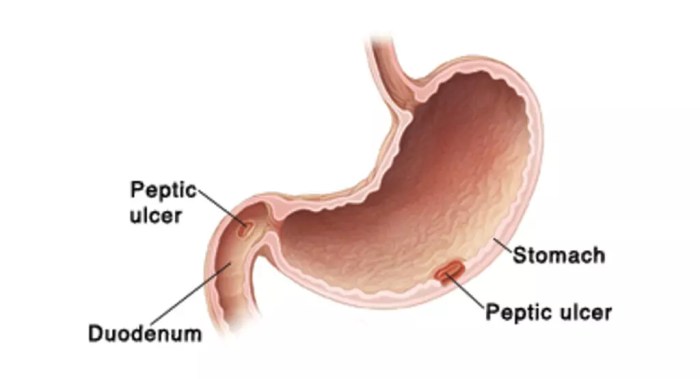What is barretts esophagus – What is Barrett’s esophagus? This condition occurs when the lining of your esophagus, the tube connecting your mouth and stomach, changes. It’s a significant health concern that can lead to serious complications if not properly managed. This in-depth exploration will delve into the causes, symptoms, diagnosis, complications, treatment options, and preventative measures associated with Barrett’s esophagus.
The transformation of the esophageal lining is a crucial factor to understand. Understanding the potential triggers and risk factors is equally important. This article will walk you through the details, offering a comprehensive overview of the condition.
Introduction to Barrett’s Esophagus: What Is Barretts Esophagus
Barrett’s esophagus is a condition where the lining of the lower part of the esophagus, the tube connecting the mouth to the stomach, changes. Normally, this lining is made of a special type of tissue called squamous epithelium. In Barrett’s esophagus, this tissue is replaced by a different type of tissue called intestinal metaplasia, resembling the lining of the intestines.
This change can occur over time and is often linked to chronic acid reflux.The underlying cause of Barrett’s esophagus is primarily chronic acid reflux. The constant exposure of the esophageal lining to stomach acid damages the tissue, leading to the cellular changes that characterize Barrett’s esophagus. While exact triggers are not always clear, long-term exposure to stomach acid is a key factor.
Risk Factors
Several factors increase the risk of developing Barrett’s esophagus. A significant risk factor is a history of gastroesophageal reflux disease (GERD). Individuals with frequent heartburn, acid indigestion, or other symptoms of GERD are at higher risk. Age is also a factor, as the risk increases with advancing age. Obesity and smoking are additional risk factors.
These lifestyle choices can exacerbate acid reflux, increasing the likelihood of tissue damage. Family history of Barrett’s esophagus also plays a role, suggesting a possible genetic predisposition.
Symptoms
Barrett’s esophagus itself rarely causes noticeable symptoms. However, the underlying condition, GERD, frequently presents with various symptoms. The symptoms often overlap with other conditions, making early diagnosis challenging. Here’s a table summarizing common symptoms:
| Symptom | Description | Potential Severity |
|---|---|---|
| Heartburn | A burning sensation in the chest, often radiating to the neck or throat, typically occurring after eating or lying down. | Mild to moderate; often a frequent complaint. |
| Acid Indigestion | A sour or acidic taste in the mouth, often accompanied by a burning sensation in the esophagus. | Mild to moderate; can be intermittent. |
| Regurgitation | The backward flow of stomach contents into the esophagus, sometimes accompanied by a sour or bitter taste. | Can range from mild to severe, potentially causing discomfort or difficulty swallowing. |
| Difficulty Swallowing (Dysphagia) | A feeling of food getting stuck in the chest or throat. This can occur due to the damaged esophageal tissue. | May indicate more advanced disease and can be associated with discomfort and potential complications. |
| Chest Pain | A pain or discomfort in the chest area, potentially mimicking a heart attack. It’s crucial to seek medical attention for any chest pain. | Can be severe and warrants immediate medical evaluation. |
Diagnosis and Evaluation

Identifying Barrett’s esophagus requires a meticulous approach, combining various diagnostic procedures to pinpoint the presence and extent of the condition. Accurate diagnosis is crucial for determining the appropriate management strategy and preventing potential complications. The process often involves a series of steps, from initial evaluation to confirmatory testing.
Barrett’s esophagus is a condition where the lining of your esophagus changes, increasing the risk of esophageal cancer. It’s important to remember that while related to digestive health, it’s crucial to be proactive about your overall well-being. Knowing how to check for breast cancer, for example, is equally important for women of all ages, and that’s something you can learn more about here.
Ultimately, staying informed about your health, including recognizing the signs of Barrett’s esophagus, is key to preventative care.
Common Diagnostic Procedures
Several diagnostic procedures are employed to evaluate individuals suspected of having Barrett’s esophagus. These methods aim to visualize the esophageal lining, assess its cellular characteristics, and determine the extent of the condition. The cornerstone of this process is often an upper endoscopy.
Role of Endoscopy in Diagnosis
Upper endoscopy plays a vital role in diagnosing Barrett’s esophagus. This procedure involves inserting a thin, flexible tube equipped with a camera (endoscope) into the esophagus, stomach, and sometimes the duodenum. The endoscope allows physicians to visualize the esophageal lining directly and identify any abnormalities, such as changes in the color or texture of the tissue. Through this visual examination, subtle changes characteristic of Barrett’s esophagus can be detected, enabling further investigation.
Significance of Biopsies in Confirmation
Confirming a Barrett’s esophagus diagnosis relies heavily on biopsies. During endoscopy, small tissue samples (biopsies) are taken from areas suspected of having abnormal cells. These biopsies are then sent to a pathologist for microscopic examination. The pathologist meticulously analyzes the tissue samples under a microscope, looking for specific cellular characteristics indicative of Barrett’s esophagus. The presence of specialized cells, such as intestinal metaplasia, is a key indicator of the condition.
The absence of these cells would rule out the possibility of Barrett’s esophagus.
Steps Involved in an Upper Endoscopy Procedure
The upper endoscopy procedure typically involves the following steps:
- Preparation: Patients are typically asked to fast for several hours before the procedure to empty the stomach and reduce the risk of complications.
- Positioning: The patient is positioned comfortably, often lying on their back or slightly on their left side.
- Insertion of the endoscope: A thin, flexible tube with a camera and light source (endoscope) is carefully guided through the mouth and into the esophagus.
- Visualization and examination: The physician uses the endoscope to visualize the esophageal lining, noting any unusual coloration, texture, or other abnormalities.
- Biopsy collection: If necessary, the physician takes small tissue samples (biopsies) from areas suspected of having abnormal cells. These samples are essential for confirmation of Barrett’s esophagus and to look for dysplasia.
- Removal of the endoscope: The endoscope is carefully withdrawn, and the patient is monitored for any discomfort.
- Post-procedure care: Patients are typically observed for a short period after the procedure to ensure they are recovering well.
Diagnostic Tests and Their Purposes
A table outlining various diagnostic tests used in evaluating Barrett’s esophagus, along with their purposes and procedures:
| Test | Purpose | Procedure |
|---|---|---|
| Upper Endoscopy | Visualize the esophageal lining and identify any abnormalities | Insertion of a flexible tube with a camera (endoscope) into the esophagus. |
| Biopsy | Confirm the presence of Barrett’s esophagus and assess for dysplasia | Collection of small tissue samples from the esophagus for microscopic analysis. |
| Histological Examination | Microscopic analysis of biopsy samples to identify specific cellular characteristics. | Pathologist examines tissue under a microscope, searching for cellular changes indicative of Barrett’s esophagus. |
Complications of Barrett’s Esophagus
Barrett’s esophagus, while often a manageable condition, carries a significant risk of developing more serious complications. Understanding these potential issues is crucial for individuals with Barrett’s esophagus and their healthcare providers. Early detection and appropriate management can significantly reduce the risk of these complications and improve patient outcomes.Esophageal cancer is a critical concern for those diagnosed with Barrett’s esophagus.
The abnormal tissue changes characteristic of Barrett’s esophagus create a fertile ground for the development of precancerous lesions, increasing the likelihood of cancerous transformation. This transformation can be a slow process, sometimes spanning years, but its potential severity underscores the importance of regular screenings and vigilant monitoring.
Increased Risk of Esophageal Cancer
Barrett’s esophagus significantly increases the risk of esophageal adenocarcinoma, a type of esophageal cancer. This heightened risk is directly related to the presence of abnormal cells in the lining of the esophagus. These cells, while not cancerous initially, have the potential to develop into cancerous cells over time. The risk is not uniform across all individuals with Barrett’s esophagus, and various factors contribute to its variability.
Factors like the extent of Barrett’s esophagus, the presence of dysplasia (precancerous changes), and individual genetic predisposition play a crucial role in determining the precise level of risk.
Progression from Barrett’s Esophagus to Esophageal Cancer
The progression from Barrett’s esophagus to esophageal cancer is a complex process, often taking years. It typically involves the development of precancerous changes, known as dysplasia, within the abnormal esophageal tissue. Dysplasia comes in varying degrees, with low-grade dysplasia representing an early stage and high-grade dysplasia indicating a higher risk of cancerous transformation. If left untreated, high-grade dysplasia can progress to invasive esophageal adenocarcinoma.
This progression highlights the critical need for regular endoscopic surveillance to detect and manage dysplasia at early stages.
Importance of Regular Screenings
Regular endoscopic screenings are essential for individuals with Barrett’s esophagus. These procedures allow healthcare professionals to visualize the esophageal lining and identify any abnormalities, including dysplasia. Early detection of dysplasia enables timely interventions, potentially preventing the progression to esophageal cancer. Screening frequency is tailored to the individual’s risk profile, taking into account factors like the extent of Barrett’s esophagus, the presence of dysplasia, and the patient’s overall health.
For instance, a patient with extensive Barrett’s esophagus and high-grade dysplasia may require more frequent screenings than someone with a smaller area of affected tissue and no dysplasia.
Summary of Complications
| Complication | Risk Factors | Prevention Strategies |
|---|---|---|
| Esophageal Cancer (Adenocarcinoma) | Barrett’s esophagus, dysplasia, age, male gender, smoking, obesity, reflux | Regular endoscopic surveillance, early detection and treatment of dysplasia, lifestyle modifications (weight management, smoking cessation) |
| Dysplasia (Precancerous Changes) | Chronic acid reflux, extent of Barrett’s esophagus, genetic predisposition | Aggressive management of GERD, regular endoscopic surveillance, and lifestyle modifications. |
| Strictures (Narrowing of the Esophagus) | Chronic acid reflux, inflammation | Treatment of GERD, endoscopic dilation as needed |
| Bleeding | Inflammation, erosion of the esophageal lining | Prompt medical intervention for bleeding episodes, management of underlying conditions. |
Management and Treatment
Barrett’s esophagus necessitates careful management to mitigate the risk of esophageal cancer. Effective strategies encompass a multifaceted approach, prioritizing lifestyle adjustments, regular medical monitoring, and prompt intervention when necessary. This section will delve into the various treatment modalities, emphasizing their efficacy and potential side effects.
Lifestyle Modifications
Lifestyle modifications play a crucial role in managing Barrett’s esophagus, particularly in reducing the risk of progression to esophageal cancer. Dietary changes, weight management, and cessation of smoking are key components of this approach. Maintaining a healthy weight and adopting a balanced diet low in processed foods and high in fruits and vegetables are generally recommended.
Barrett’s esophagus is a condition where the lining of your esophagus changes, often due to chronic acid reflux. This altered lining can increase the risk of esophageal cancer. Interestingly, some studies suggest a potential link between this condition and levels of very low density lipoprotein vldl very low density lipoprotein vldl in the body, though the exact mechanisms are still being investigated.
Ultimately, understanding Barrett’s esophagus requires further research and careful monitoring for early detection.
- Dietary Changes: A diet rich in fruits, vegetables, and whole grains can help maintain a healthy weight and reduce inflammation in the esophagus. Avoiding excessive alcohol consumption and limiting intake of spicy or acidic foods can also contribute to comfort and reduce esophageal irritation.
- Weight Management: Maintaining a healthy weight is associated with a lower risk of developing esophageal cancer. Weight loss, if needed, should be achieved gradually and under the guidance of a healthcare professional.
- Smoking Cessation: Smoking is a significant risk factor for esophageal cancer. Quitting smoking is a crucial step in managing Barrett’s esophagus and improving overall health.
Medical Management
Acid-reducing medications are frequently used to manage Barrett’s esophagus. These medications aim to lower the acidity of the stomach contents, thereby reducing the reflux of stomach acid into the esophagus.
- Proton Pump Inhibitors (PPIs): PPIs, such as omeprazole and pantoprazole, are commonly prescribed to reduce acid production in the stomach. They are generally well-tolerated, but long-term use can occasionally lead to side effects like abdominal discomfort, diarrhea, or headaches. Careful monitoring and appropriate dosage adjustments are important.
- H2 Receptor Antagonists: These medications, such as cimetidine and famotidine, also reduce stomach acid production but may be less effective than PPIs in some cases. They are typically used as a first-line treatment for mild symptoms.
Endoscopic Procedures
Endoscopic procedures are often used to monitor and manage Barrett’s esophagus. These procedures involve inserting a flexible tube with a camera (endoscope) into the esophagus to visualize the lining and obtain tissue samples for analysis.
- Endoscopic Mucosal Resection (EMR): EMR is a procedure used to remove abnormal tissue from the esophagus. It is typically performed in cases where high-grade dysplasia or early esophageal cancer is suspected. The efficacy of EMR in preventing progression to esophageal cancer is well-established in various clinical trials.
- Radiofrequency Ablation (RFA): RFA is another endoscopic procedure that uses heat to destroy abnormal tissue in the esophagus. It is an alternative to EMR for treating Barrett’s esophagus with high-grade dysplasia.
Treatment Efficacy and Side Effects
The following table summarizes various treatment approaches for Barrett’s esophagus, including their efficacy and potential side effects.
| Treatment Method | Efficacy | Potential Side Effects |
|---|---|---|
| Lifestyle Modifications | Reduces reflux symptoms, improves quality of life | Requires patient commitment and adherence to lifestyle changes |
| PPIs | Effective in reducing reflux symptoms, often first-line treatment | Potential for abdominal discomfort, diarrhea, headaches (rare), and long-term use can affect vitamin B12 absorption |
| H2 Receptor Antagonists | Reduces reflux symptoms, less effective than PPIs | Generally well-tolerated, but may not be as effective as PPIs |
| EMR | High efficacy in removing abnormal tissue, reducing risk of esophageal cancer | Possible complications include bleeding, perforation, and stricture formation |
| RFA | Effective in destroying abnormal tissue, alternative to EMR | Potential for complications like bleeding, perforation, and stricture formation |
Prevention and Screening
Barrett’s esophagus, while often manageable, can progress to a more serious condition. Proactive measures in prevention and early detection are crucial in mitigating potential risks and improving treatment outcomes. This section will explore strategies for preventing Barrett’s esophagus and the importance of regular screenings for individuals at risk.Understanding the risk factors associated with Barrett’s esophagus is essential for implementing effective preventative measures.
Lifestyle modifications and regular screenings can significantly reduce the likelihood of developing this condition and its potential complications.
Strategies for Preventing Barrett’s Esophagus
A healthy lifestyle plays a pivotal role in reducing the risk of Barrett’s esophagus. Maintaining a balanced diet, regular exercise, and avoiding smoking and excessive alcohol consumption are key strategies. Obesity is a significant risk factor, so weight management through a combination of diet and exercise is important.
- Maintaining a Healthy Weight: Maintaining a healthy weight through balanced nutrition and regular physical activity is a crucial step in reducing the risk of Barrett’s esophagus. Studies have shown a strong correlation between obesity and the development of the condition.
- Adopting a Balanced Diet: A diet rich in fruits, vegetables, and whole grains, while limiting processed foods, sugary drinks, and red meat, can contribute to overall health and potentially reduce the risk. Focus on fiber-rich foods and a diet low in saturated fats.
- Quitting Smoking: Smoking significantly increases the risk of developing Barrett’s esophagus. Quitting smoking is one of the most impactful steps individuals can take to reduce their risk.
- Limiting Alcohol Consumption: Excessive alcohol consumption can irritate the esophagus and increase the risk of developing Barrett’s esophagus. Moderation in alcohol intake is crucial.
Importance of Regular Screenings
Regular screenings are essential for individuals at risk of developing Barrett’s esophagus. Early detection allows for prompt intervention, potentially preventing the progression to more serious complications. These screenings can identify precancerous changes in the lining of the esophagus before they progress to cancer.
- Identifying Precancerous Changes: Regular screenings can detect precancerous changes in the esophageal lining, allowing for early intervention and preventing the progression to esophageal adenocarcinoma.
- Improving Treatment Outcomes: Early detection enables prompt treatment, increasing the likelihood of successful management and minimizing the risk of complications.
- Personalized Screening Recommendations: Screening recommendations should be tailored to individual risk factors, considering factors such as age, smoking history, and family history of esophageal cancer.
Lifestyle Changes to Reduce Risk
Implementing lifestyle changes is a key component in reducing the risk of Barrett’s esophagus. These changes can improve overall health and reduce the risk of developing precancerous conditions.
- Dietary Modifications: Focus on a diet rich in fruits, vegetables, and whole grains while limiting processed foods, sugary drinks, and red meat.
- Regular Exercise: Engaging in regular physical activity helps maintain a healthy weight and promotes overall well-being, contributing to a reduced risk.
- Stress Management Techniques: Chronic stress can negatively impact health, potentially increasing the risk of Barrett’s esophagus. Employing stress management techniques such as meditation, yoga, or deep breathing exercises can be beneficial.
Significance of Early Detection
Early detection of Barrett’s esophagus is critical for improving treatment outcomes. The earlier precancerous changes are identified, the greater the chance of successful intervention and the prevention of more advanced disease. This can significantly reduce the risk of esophageal cancer.
Comparison of Screening Protocols
The following table Artikels different screening protocols for Barrett’s esophagus, highlighting their frequency, target population, and advantages/disadvantages.
| Screening Protocol | Frequency | Target Population | Advantages | Disadvantages |
|---|---|---|---|---|
| Upper Endoscopy with Biopsy | Annually or every 3-5 years | Individuals with Barrett’s esophagus | Highly accurate in identifying precancerous changes | Invasive procedure; potential discomfort and complications |
| Esophageal pH Monitoring | Annually or every 2-3 years | Individuals with GERD symptoms | Less invasive; helpful in assessing reflux severity | May not detect all precancerous changes; lower accuracy |
| Endoscopic Ultrasound | Every 2-3 years | Individuals with suspected esophageal abnormalities | Provides detailed images of the esophagus and surrounding tissues | More expensive; more invasive than pH monitoring |
Patient Education and Support
Navigating a Barrett’s esophagus diagnosis can be emotionally challenging. Understanding the condition, its implications, and available resources is crucial for effective management and improved quality of life. This section focuses on empowering patients with the knowledge and support networks necessary for successful coping and treatment adherence.Patient education plays a vital role in managing Barrett’s esophagus. By equipping patients with the necessary information, healthcare providers can facilitate better self-management and encourage proactive engagement in their care.
This includes understanding the condition’s progression, potential complications, and the importance of regular check-ups.
Importance of Patient Education
Thorough patient education empowers individuals to actively participate in their care. Knowledge about Barrett’s esophagus allows patients to recognize symptoms, understand treatment options, and make informed decisions about their health. This proactive approach leads to better adherence to medical recommendations and ultimately, improved outcomes.
Barrett’s esophagus is a condition where the lining of your esophagus changes, often due to chronic acid reflux. While managing such conditions can be tough, finding effective migraine relief can also be challenging. Fortunately, exploring pressure point techniques like those detailed in this article on migraine relief pressure points might offer some relief, although it’s important to remember that these techniques are not a replacement for proper medical advice and treatment for Barrett’s esophagus.
Ultimately, understanding and addressing Barrett’s esophagus requires a personalized approach from a healthcare professional.
Role of Support Groups
Support groups provide a vital network for individuals facing similar challenges. These groups offer a safe space for sharing experiences, offering encouragement, and learning from others’ journeys. The shared understanding and empathy fostered within these groups can significantly reduce feelings of isolation and anxiety.
Resources for Support and Educational Materials, What is barretts esophagus
Numerous resources are available to aid patients in accessing support and educational materials. The National Institutes of Health (NIH) website, along with other reputable medical organizations, provides comprehensive information on Barrett’s esophagus. Local hospitals and clinics often have patient education programs and support groups.
Managing the Emotional Impact
A Barrett’s esophagus diagnosis can evoke a range of emotions, including anxiety, fear, and uncertainty. Acknowledging and addressing these emotional responses is crucial for mental well-being. Open communication with healthcare providers, utilizing available support systems, and practicing stress-reducing techniques are beneficial strategies for managing these challenges. Seeking professional counseling can be beneficial for individuals experiencing significant emotional distress.
Frequently Asked Questions (FAQ)
Q: What are the typical symptoms of Barrett’s esophagus?
A: Symptoms can vary, but common signs include heartburn, difficulty swallowing, and regurgitation.
Q: How is Barrett’s esophagus diagnosed?
A: Diagnosis typically involves an endoscopy, where a thin, flexible tube with a camera is inserted into the esophagus to visualize the lining and collect tissue samples for biopsy.
Q: Is Barrett’s esophagus always cancerous?
A: No, not all cases of Barrett’s esophagus progress to esophageal cancer. However, it’s a precancerous condition that increases the risk of esophageal cancer.
Q: What are the treatment options for Barrett’s esophagus?
A: Treatment options depend on the individual’s specific case and may include lifestyle modifications, medications, and endoscopic procedures, including ablation.
Q: What are the long-term implications of Barrett’s esophagus?
A: Long-term implications depend on the severity of the condition and adherence to treatment plans. Close monitoring and regular check-ups are essential.
Illustrative Case Studies
Understanding Barrett’s esophagus through real-life examples provides invaluable insight into its diagnosis, treatment, and patient experience. These case studies highlight the complexities of the condition and underscore the importance of personalized care. Each case illustrates the journey of a patient navigating this health challenge.
A Case Study of Mr. Smith
Mr. Smith, a 55-year-old male, presented with persistent heartburn and occasional regurgitation. His symptoms had been ongoing for several years, initially attributed to lifestyle factors. However, his symptoms progressively worsened, prompting him to seek medical attention. During his endoscopy, the physician observed a change in the esophageal lining.
Diagnosis and Evaluation
The endoscopy revealed a segment of the esophagus exhibiting metaplasia, a key characteristic of Barrett’s esophagus. Biopsies were taken to confirm the presence of specialized cells. Further investigations, including upper endoscopy with biopsies, determined the extent of the Barrett’s esophagus and the presence of any precancerous changes. The pathologist’s report confirmed the diagnosis.
Treatment and Outcome
Given the extent of Barrett’s esophagus, Mr. Smith was recommended a treatment plan involving regular endoscopic surveillance. This involves periodic endoscopies to monitor the esophageal lining for any signs of dysplasia or cancer. Mr. Smith was educated on the importance of adhering to a low-acid diet, lifestyle modifications, and managing his heartburn symptoms effectively.
He was also informed about the potential need for endoscopic procedures if precancerous changes or cancer developed. Following a period of strict adherence to the prescribed treatment, Mr. Smith’s condition remained stable.
Patient Experience and Challenges
Mr. Smith’s experience highlighted the emotional toll of a chronic condition like Barrett’s esophagus. The uncertainty of the condition, the need for frequent follow-up appointments, and the ongoing lifestyle adjustments were challenging. However, through open communication with his healthcare team, he developed a comprehensive understanding of the condition and strategies to effectively manage it. The importance of emotional support and patient education was crucial to his successful management of the condition.
Importance of Personalized Care
The management of Barrett’s esophagus requires a personalized approach, considering individual factors such as the extent of the condition, the presence of precancerous changes, and the patient’s overall health. Mr. Smith’s experience emphasizes the necessity of tailored treatment plans to address the unique needs of each patient. This personalized approach involves open communication between the patient and healthcare team, ensuring the patient feels supported and empowered to manage their condition effectively.
Illustrative Image: Esophageal Lining
Imagine a healthy esophagus. The lining appears smooth and a consistent pink color. The cells are organized in a predictable manner. Now, contrast this with the esophageal lining in a patient with Barrett’s esophagus. The lining shows a significant change.
In the affected area, the cells lining the esophagus are different in shape and structure, exhibiting a columnar pattern, which is atypical for the normal squamous epithelium of the esophagus. The abnormal cells are often larger and taller than normal esophageal cells, and may contain goblet cells, which are not normally found in the esophageal lining. This cellular transformation is a key indicator of Barrett’s esophagus.
Last Point

In summary, Barrett’s esophagus is a condition requiring careful attention and proactive management. Early detection and consistent monitoring are key to minimizing complications and improving long-term outcomes. By understanding the risk factors, symptoms, and treatment options, individuals can take an active role in their health management and seek professional support when needed.




